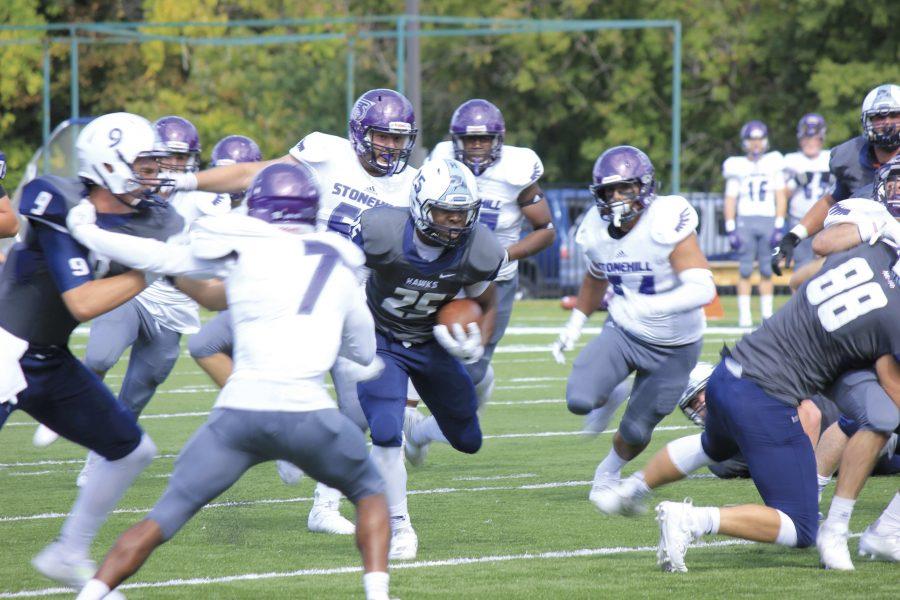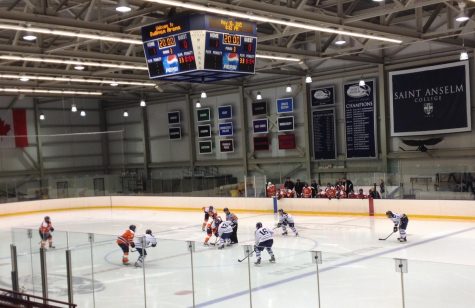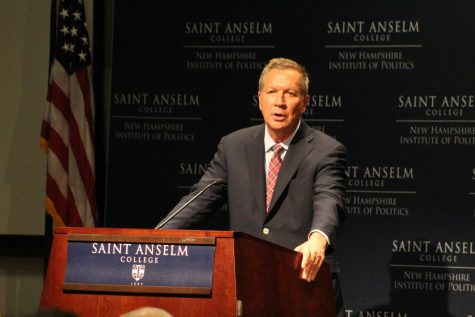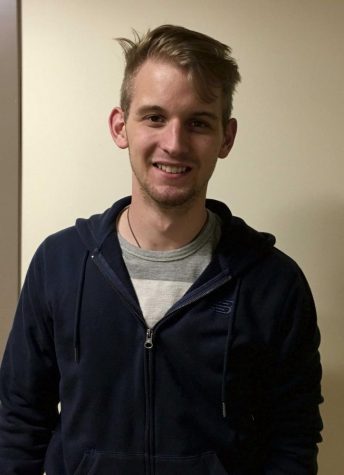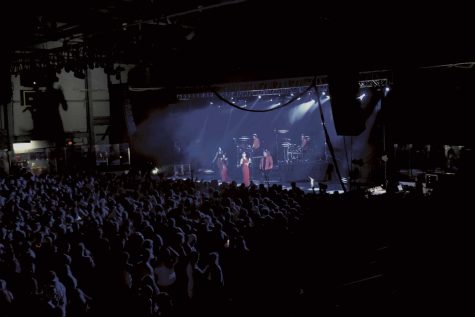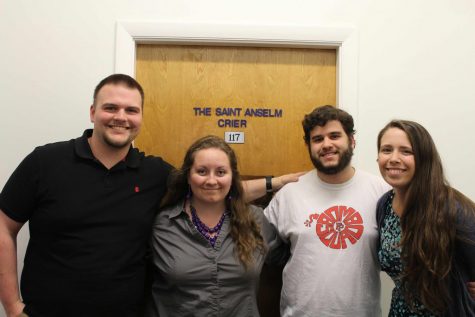Hawk players join Kaepernick-inspired protest
Gabe Elliott ’20 on the field for St. A’s against Stonehill on Saturday Sept. 24.
September 28, 2016
While a Saint Anselm student sang the national anthem at this past Saturday’s football game most of the Saint Anselm College football team stood in a line with their hand over their heart, but many people did not notice that at the end of the line three Saint A’s players stood, raising their fists in protest. One of these players was senior Kyrel Jaundoo.
Although The Crier made many attempt to attain a statement from Jaundoo about his protest, he did not comment.
The three football players who protested reflect a movement of protests during the national anthem that has been sweeping through the National Football League. The movement began with San Francisco 49ers quarterback Colin Kaepernick. Kaepernick began by sitting during the national anthem at preseason games to “show support for people of color who are being oppressed in the United States and to take a stand against police brutality.” This movement has grown and morphed as NFL players and other athletes have joined Kaepernick in protesting during the national anthem.
A football player, who will remain anonymous, revealed to The Crier that Kyrel Jaundoo began protesting during the national anthem at the previous football game on Saturday, Sept.17 at New Haven by kneeling. Like Kaepernick, however, Juandoo changed the posture he used to protest, choosing to raise a fist while standing at the home game on Sept. 24. The decision to change the posture of protesting is a common theme throughout the NFL, and exposes the very emotional reactions people have to symbolic gestures.
Sitting, kneeling, raising a fist, linking arms; these are all postures NFL football players have used to protest during the national anthem. Some teams, such as the Miami Dolphins, have expressed clearly what their body language was symbolic of telling Time Magazine that “locking arms during the nation anthem [is] a way to show unity as a team if not uniformity in their opinions.”
Different positions evoke distinct reactions from onlookers. Many people criticized Kaepernick for sitting during the national anthem calling him unpatriotic, disrespectful to troops, and even an ISIS sympathizer. Kaepernick had a discussion with former NFL long snapper Nate Boyer, which led to Kaepernick deciding to kneel instead of sit during the national anthem. Although many people still criticized Kaepernick for not standing, others found that kneeling was more respectful.
Raising a fist, which was the form of protest chosen by the Saint Anselm Football players, has much deeper roots than the rest of the poses. A raised fist, especially while protesting for the rights of people of color, hearkens back to the Black Power movement of the 1960s.
This is not the first time that athletes have used their position of privilege and prominence to protest. Tommie Smith and John Carlos raised their black leather gloved fists in a Black Power salute at the 1968 Olympics. However Smith later stated that the gesture was not a “Black Power” salute, but a “human rights salute”. Proving that although these symbolic gestures are powerful their meaning is not always clear.
The Crier learned from a Saint Anselm football player who will remain anonymous that he supports Kyrel’s protest and wanted to join him in protesting at future games. The player stated that Head Coach Joe Adams supported the players exercising their right to protest but wanted all the players to be unified.
But there seems to be more division than unity in player’s attitudes towards protests during the national anthem. The Crier interviewed a different football player who also asked to remain anonymous.
This second football player said that Kyrel’s protest “does not reflect on the whole football team”. He added “I think kneeling during the national anthem is disrespectful and there are other ways to create awareness of social justice issues. I believe the majority of the team believes in honoring the flag”.
He also told echoed the first player by telling The Crier that “Coach Adam said he respects the issues being raised but also that it is in the best interest of the team and the college to stand.” This may be why the players chose to stand and raise their fists at the Sept. 24 home game.
When asked for a comment on the protest, Dr. Steven DiSalvo, College President, stated, “While acts of protest by athletes or student-athletes during the national anthem are perceived by some to be disrespectful, individuals have a right to express their personal beliefs. I have advised our Athletic Director, Daron Montgomery, to address this issue with our coaching staffs, so that all coaches clearly articulate team expectations, address issues of diversity and inclusiveness with their teams, and understand that students have a right to respectfully protest.”



